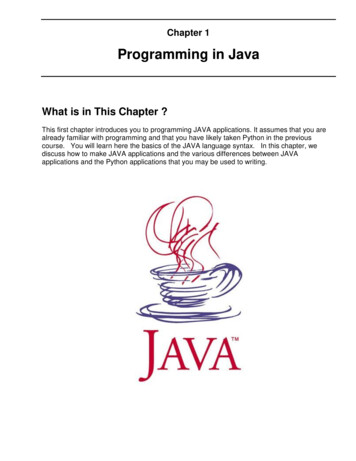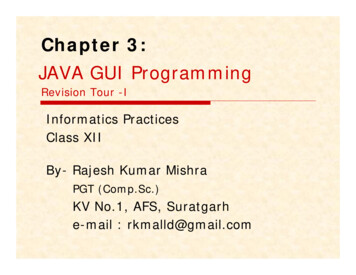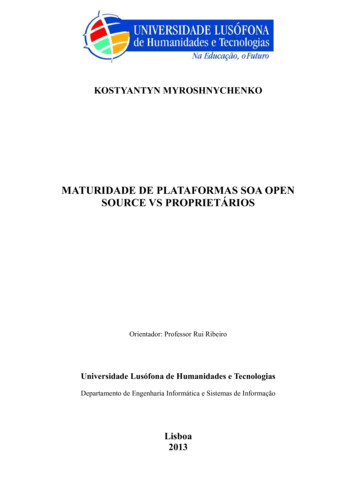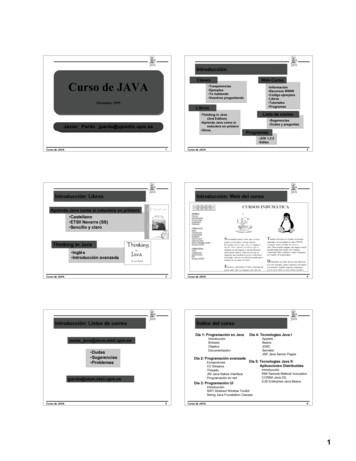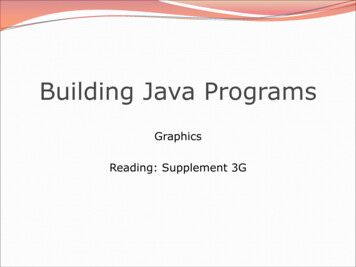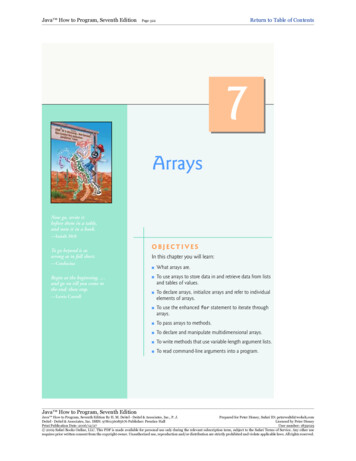
Transcription
Java How to Program, Seventh EditionReturn to Table of ContentsPage 3227ArraysNow go, write itbefore them in a table,and note it in a book.—Isaiah 30:8To go beyond is aswrong as to fall short.—ConfuciusBegin at the beginning, and go on till you come tothe end: then stop.—Lewis CarrollOBJECTIVESIn this chapter you will learn: What arrays are. To use arrays to store data in and retrieve data from listsand tables of values. To declare arrays, initialize arrays and refer to individualelements of arrays. To use the enhanced for statement to iterate througharrays. To pass arrays to methods. To declare and manipulate multidimensional arrays. To write methods that use variable-length argument lists. To read command-line arguments into a program.Java How to Program, Seventh EditionJava How to Program, Seventh Edition By H. M. Deitel - Deitel & Associates, Inc., P. J.Prepared for Peter Disney, Safari ID: peterwaltd@wokeh.comDeitel - Deitel & Associates, Inc. ISBN: 9780136085676 Publisher: Prentice HallLicensed by Peter DisneyPrint Publication Date: 2006/12/27User number: 1839029 2009 Safari Books Online, LLC. This PDF is made available for personal use only during the relevant subscription term, subject to the Safari Terms of Service. Any other userequires prior written consent from the copyright owner. Unauthorized use, reproduction and/or distribution are strictly prohibited and violate applicable laws. All rights reserved.
Java How to Program, Seventh 117.127.137.147.15Chapter 7Page 323Return to Table of ContentsArraysIntroductionArraysDeclaring and Creating ArraysExamples Using ArraysCase Study: Card Shuffling and Dealing SimulationEnhanced for StatementPassing Arrays to MethodsCase Study: Class GradeBook Using an Array to Store GradesMultidimensional ArraysCase Study: Class GradeBook Using a Two-Dimensional ArrayVariable-Length Argument ListsUsing Command-Line Arguments(Optional) GUI and Graphics Case Study: Drawing Arcs(Optional) Software Engineering Case Study: Collaboration Among ObjectsWrap-UpSummary Terminology Self-Review Exercises Answers to Self-Review Exercises Exercises Special Section: Building Your Own Computer7.1 IntroductionThis chapter introduces data structures—collections of related data items. Arrays are datastructures consisting of related data items of the same type. Arrays are fixed-length entities—they remain the same length once they are created, although an array variable maybe reassigned such that it refers to a new array of a different length. We study data structures in depth in Chapters 17–19.After discussing how arrays are declared, created and initialized, we present a series ofpractical examples that demonstrate several common array manipulations. We also presenta case study that examines how arrays can help simulate the shuffling and dealing ofplaying cards for use in an application that implements a card game. The chapter thenintroduces Java’s enhanced for statement, which allows a program to access the data in anarray more easily than does the counter-controlled for statement presented in Section 5.3.Two sections of the chapter enhance the case study of class GradeBook in Chapters 3–5.In particular, we use arrays to enable the class to maintain a set of grades in memory andanalyze student grades from multiple exams in a semester—two capabilities that wereabsent from previous versions of the class. These and other chapter examples demonstratethe ways in which arrays allow programmers to organize and manipulate data.7.2 ArraysAn array is a group of variables (called elements or components) containing values that allhave the same type. Recall that types are divided into two categories—primitive types andreference types. Arrays are objects, so they are considered reference types. As you will soonsee, what we typically think of as an array is actually a reference to an array object in mem-Java How to Program, Seventh EditionJava How to Program, Seventh Edition By H. M. Deitel - Deitel & Associates, Inc., P. J.Prepared for Peter Disney, Safari ID: peterwaltd@wokeh.comDeitel - Deitel & Associates, Inc. ISBN: 9780136085676 Publisher: Prentice HallLicensed by Peter DisneyPrint Publication Date: 2006/12/27User number: 1839029 2009 Safari Books Online, LLC. This PDF is made available for personal use only during the relevant subscription term, subject to the Safari Terms of Service. Any other userequires prior written consent from the copyright owner. Unauthorized use, reproduction and/or distribution are strictly prohibited and violate applicable laws. All rights reserved.
Java How to Program, Seventh EditionReturn to Table of ContentsPage 3247.2 Arrays297ory. The elements of an array can be either primitive types or reference types (includingarrays, as we will see in Section 7.9). To refer to a particular element in an array, we specifythe name of the reference to the array and the position number of the element in the array.The position number of the element is called the element’s index or subscript.Figure 7.1 shows a logical representation of an integer array called c. This array contains 12 elements. A program refers to any one of these elements with an array-accessexpression that includes the name of the array followed by the index of the particular element in square brackets ([]). The first element in every array has index zero and is sometimes called the zeroth element. Thus, the elements of array c are c[ 0 ], c[ 1 ], c[ 2 ]and so on. The highest index in array c is 11, which is 1 less than 12—the number of elements in the array. Array names follow the same conventions as other variable names.An index must be a nonnegative integer. A program can use an expression as an index.For example, if we assume that variable a is 5 and variable b is 6, then the statementc[ a b ] 2;adds 2 to array element c[ 11 ]. Note that an indexed array name is an array-access expression. Such expressions can be used on the left side of an assignment to place a new valueinto an array element.Common Programming Error 7.1Using a value of type long as an array index results in a compilation error. An index must bean int value or a value of a type that can be promoted to int—namely, byte, short or char,but not long.7.1Let us examine array c in Fig. 7.1 more closely. The name of the array is c. Every arrayobject knows its own length and maintains this information in a length field. The expression c.length accesses array c’s length field to determine the length of the array. Notethat, even though the length member of an array is public, it cannot be changed becauseName of array (c)Index (or subcript) of theelement in array cc[ 0 ]-45c[ 1 ]6c[ 2 ]0c[ 3 ]72c[ 4 ]1543c[ 5 ]-89c[ 6 ]0c[ 7 ]62c[ 8 ]-3c[ 9 ]1c[ 10 ]6453c[ 11 ]78Fig. 7.1 A 12-element array.Java How to Program, Seventh EditionJava How to Program, Seventh Edition By H. M. Deitel - Deitel & Associates, Inc., P. J.Prepared for Peter Disney, Safari ID: peterwaltd@wokeh.comDeitel - Deitel & Associates, Inc. ISBN: 9780136085676 Publisher: Prentice HallLicensed by Peter DisneyPrint Publication Date: 2006/12/27User number: 1839029 2009 Safari Books Online, LLC. This PDF is made available for personal use only during the relevant subscription term, subject to the Safari Terms of Service. Any other userequires prior written consent from the copyright owner. Unauthorized use, reproduction and/or distribution are strictly prohibited and violate applicable laws. All rights reserved.
Java How to Program, Seventh Edition298Chapter 7Page 325Return to Table of ContentsArraysit is a final variable. This array’s 12 elements are referred to as c[ 0 ], c[ 1 ], c[ 2 ], ,c[ 11 ]. The value of c[ 0 ] is -45, the value of c[ 1 ] is 6, the value of c[ 2 ] is 0, the valueof c[ 7 ] is 62 and the value of c[ 11 ] is 78. To calculate the sum of the values containedin the first three elements of array c and store the result in variable sum, we would writesum c[ 0 ] c[ 1 ] c[ 2 ];To divide the value of c[ 6 ] by 2 and assign the result to the variable x, we would writex c[ 6 ] / 2;7.3 Declaring and Creating ArraysArray objects occupy space in memory. Like other objects, arrays are created with keywordnew. To create an array object, the programmer specifies the type of the array elements andthe number of elements as part of an array-creation expression that uses keyword new.Such an expression returns a reference that can be stored in an array variable. The following declaration and array-creation expression create an array object containing 12 int elements and store the array’s reference in variable c:int c[] new int[ 12 ];This expression can be used to create the array shown in Fig. 7.1. This task also can beperformed in two steps as follows:int c[];c new int[ 12 ];// declare the array variable// create the array; assign to array variableIn the declaration, the square brackets following the variable name c indicate that c is avariable that will refer to an array (i.e., the variable will store an array reference). In theassignment statement, the array variable c receives the reference to a new array of 12 intelements. When an array is created, each element of the array receives a default value—zero for the numeric primitive-type elements, false for boolean elements and null forreferences (any nonprimitive type). As we will soon see, we can provide specific, nondefault initial element values when we create an array.Common Programming Error 7.2In an array declaration, specifying the number of elements in the square brackets of the declaration (e.g., int c[ 12 ];) is a syntax error.7.2A program can create several arrays in a single declaration. The following String arraydeclaration reserves 100 elements for b and 27 elements for x:String b[] new String[ 100 ], x[] new String[ 27 ];In this case, the class name String applies to each variable in the declaration. For readability, we prefer to declare only one variable per declaration, as in:String b[] new String[ 100 ]; // create array bString x[] new String[ 27 ]; // create array xJava How to Program, Seventh EditionJava How to Program, Seventh Edition By H. M. Deitel - Deitel & Associates, Inc., P. J.Prepared for Peter Disney, Safari ID: peterwaltd@wokeh.comDeitel - Deitel & Associates, Inc. ISBN: 9780136085676 Publisher: Prentice HallLicensed by Peter DisneyPrint Publication Date: 2006/12/27User number: 1839029 2009 Safari Books Online, LLC. This PDF is made available for personal use only during the relevant subscription term, subject to the Safari Terms of Service. Any other userequires prior written consent from the copyright owner. Unauthorized use, reproduction and/or distribution are strictly prohibited and violate applicable laws. All rights reserved.
Java How to Program, Seventh EditionReturn to Table of ContentsPage 3267.4 Examples Using Arrays299Good Programming Practice 7.1For readability, declare only one variable per declaration. Keep each declaration on a separateline, and include a comment describing the variable being declared.7.1When an array is declared, the type of the array and the square brackets can be combined at the beginning of the declaration to indicate that all the identifiers in the declaration are array variables. For example, the declarationdouble[] array1, array2;indicates that array1 and array2 are each “array of double” variables. The preceding declaration is equivalent to:double array1[];double array2[];ordouble[] array1;double[] array2;The preceding pairs of declarations are equivalent—when only one variable is declared ineach declaration, the square brackets can be placed either after the type or after the arrayvariable name.Common Programming Error 7.3Declaring multiple array variables in a single declaration can lead to subtle errors. Consider thedeclaration int[] a, b, c;. If a, b and c should be declared as array variables, then this declaration is correct—placing square brackets directly following the type indicates that all the identifiers in the declaration are array variables. However, if only a is intended to be an arrayvariable, and b and c are intended to be individual int variables, then this declaration is incorrect—the declaration int a[], b, c; would achieve the desired result.7.3A program can declare arrays of any type. Every element of a primitive-type array contains a value of the array’s declared type. Similarly, in an array of a reference type, everyelement is a reference to an object of the array’s declared type. For example, every elementof an int array is an int value, and every element of a String array is a reference to aString object.7.4 Examples Using ArraysThis section presents several examples that demonstrate declaring arrays, creating arrays,initializing arrays and manipulating array elements.Creating and Initializing an ArrayThe application of Fig. 7.2 uses keyword new to create an array of 10 int elements, whichare initially zero (the default for int variables).Line 8 declares array—a reference capable of referring to an array of int elements.Line 10 creates the array object and assigns its reference to variable array. Line 12 outputsthe column headings. The first column contains the index (0–9) of each array element,and the second column contains the default value (0) of each array element.Java How to Program, Seventh EditionJava How to Program, Seventh Edition By H. M. Deitel - Deitel & Associates, Inc., P. J.Prepared for Peter Disney, Safari ID: peterwaltd@wokeh.comDeitel - Deitel & Associates, Inc. ISBN: 9780136085676 Publisher: Prentice HallLicensed by Peter DisneyPrint Publication Date: 2006/12/27User number: 1839029 2009 Safari Books Online, LLC. This PDF is made available for personal use only during the relevant subscription term, subject to the Safari Terms of Service. Any other userequires prior written consent from the copyright owner. Unauthorized use, reproduction and/or distribution are strictly prohibited and violate applicable laws. All rights reserved.
Java How to Program, Seventh Edition300123456789101112131415161718Chapter 7Page 327Return to Table of ContentsArrays// Fig. 7.2: InitArray.java// Creating an array.public class InitArray{public static void main( String args[] ){int array[]; // declare array named arrayarray new int[ 10 ]; // create the space for arraySystem.out.printf( "%s%8s\n", "Index", "Value" ); // column headings// output each array element's valuefor ( int counter 0; counter array.length; counter )System.out.printf( "%5d%8d\n", counter, array[ counter ] );} // end main} // end class InitArrayIndex0123456789Value0000000000Fig. 7.2 Initializing the elements of an array to default values of zero.The for statement in lines 15–16 outputs the index number (represented by counter)and the value of each array element (represented by array[ counter ]). Note that the loopcontrol variable counter is initially 0—index values start at 0, so using zero-basedcounting allows the loop to access every element of the array. The for’s loop-continuationcondition uses the expression array.length (line 15) to determine the length of the array.In this example, the length of the array is 10, so the loop continues executing as long asthe value of control variable counter is less than 10. The highest index value of a 10-element array is 9, so using the less-than operator in the loop-continuation condition guarantees that the loop does not attempt to access an element beyond the end of the array (i.e.,during the final iteration of the loop, counter is 9). We will soon see what Java does whenit encounters such an out-of-range index at execution time.Using an Array InitializerA program can create an array and initialize its elements with an array initializer, which isa comma-separated list of expressions (called an initializer list) enclosed in braces ({ and}); the array length is determined by the number of elements in the initializer list. For example, the declarationint n[] { 10, 20, 30, 40, 50 };Java How to Program, Seventh EditionJava How to Program, Seventh Edition By H. M. Deitel - Deitel & Associates, Inc., P. J.Prepared for Peter Disney, Safari ID: peterwaltd@wokeh.comDeitel - Deitel & Associates, Inc. ISBN: 9780136085676 Publisher: Prentice HallLicensed by Peter DisneyPrint Publication Date: 2006/12/27User number: 1839029 2009 Safari Books Online, LLC. This PDF is made available for personal use only during the relevant subscription term, subject to the Safari Terms of Service. Any other userequires prior written consent from the copyright owner. Unauthorized use, reproduction and/or distribution are strictly prohibited and violate applicable laws. All rights reserved.
Java How to Program, Seventh EditionReturn to Table of ContentsPage 3287.4 Examples Using Arrays301creates a five-element array with index values 0, 1, 2, 3 and 4. Element n[ 0 ] is initializedto 10, n[ 1 ] is initialized to 20, and so on. This declaration does not require new to createthe array object. When the compiler encounters an array declaration that includes an initializer list, it counts the number of initializers in the list to determine the size of the array,then sets up the appropriate new operation “behind the scenes.”The application in Fig. 7.3 initializes an integer array with 10 values (line 9) and displays the array in tabular format. The code for displaying the array elements (lines 14–15)is identical to that in Fig. 7.2 (lines 15–16).Calculating the Values to Store in an ArrayThe application in Fig. 7.4 creates a 10-element array and assigns to each element one ofthe even integers from 2 to 20 (2, 4, 6, , 20). Then the application displays the array intabular format. The for statement at lines 12–13 calculates an array element’s value bymultiplying the current value of the control variable counter by 2, then adding 2.Line 8 uses the modifier final to declare the constant variable ARRAY LENGTH withthe value 10. Constant variables (also known as final variables) must be initialized beforethey are used and cannot be modified thereafter. If you attempt to modify a final variableafter it is initialized in its declaration (as in line 8), the compiler issues the error messagecannot assign a value to final variable variableName1234567891011121314151617// Fig. 7.3: InitArray.java// Initializing the elements of an array with an array initializer.public class InitArray{public static void main( String args[] ){// initializer list specifies the value for each elementint array[] { 32, 27, 64, 18, 95, 14, 90, 70, 60, 37 };System.out.printf( "%s%8s\n", "Index", "Value" ); // column headings// output each array element's valuefor ( int counter 0; counter array.length; counter )System.out.printf( "%5d%8d\n", counter, array[ counter ] );} // end main} // end class ig. 7.3 Initializing the elements of an array with an array initializer.Java How to Program, Seventh EditionJava How to Program, Seventh Edition By H. M. Deitel - Deitel & Associates, Inc., P. J.Prepared for Peter Disney, Safari ID: peterwaltd@wokeh.comDeitel - Deitel & Associates, Inc. ISBN: 9780136085676 Publisher: Prentice HallLicensed by Peter DisneyPrint Publication Date: 2006/12/27User number: 1839029 2009 Safari Books Online, LLC. This PDF is made available for personal use only during the relevant subscription term, subject to the Safari Terms of Service. Any other userequires prior written consent from the copyright owner. Unauthorized use, reproduction and/or distribution are strictly prohibited and violate applicable laws. All rights reserved.
Java How to Program, Seventh Edition302123456789101112131415161718192021Chapter 7Page 329Return to Table of ContentsArrays// Fig. 7.4: InitArray.java// Calculating values to be placed into elements of an array.public class InitArray{public static void main( String args[] ){final int ARRAY LENGTH 10; // declare constantint array[] new int[ ARRAY LENGTH ]; // create array// calculate value for each array elementfor ( int counter 0; counter array.length; counter )array[ counter ] 2 2 * counter;System.out.printf( "%s%8s\n", "Index", "Value" ); // column headings// output each array element's valuefor ( int counter 0; counter array.length; counter )System.out.printf( "%5d%8d\n", counter, array[ counter ] );} // end main} // end class InitArrayIndex0123456789Value2468101214161820Fig. 7.4 Calculating the values to be placed into the elements of an array.If an attempt is made to access the value of a final variable before it is initialized, thecompiler issues the error messagevariable variableName might not have been initializedGood Programming Practice 7.2Constant variables also are called named constants or read-only variables. Such variables oftenmake programs more readable than programs that use literal values (e.g., 10)—a named constant such as ARRAY LENGTH clearly indicates its purpose, whereas a literal value could have different meanings based on the context in which it is used.7.2Common Programming Error 7.4Assigning a value to a constant after the variable has been initialized is a compilation error.7.4Common Programming Error 7.5Attempting to use a constant before it is initialized is a compilation error.7.5Java How to Program, Seventh EditionJava How to Program, Seventh Edition By H. M. Deitel - Deitel & Associates, Inc., P. J.Prepared for Peter Disney, Safari ID: peterwaltd@wokeh.comDeitel - Deitel & Associates, Inc. ISBN: 9780136085676 Publisher: Prentice HallLicensed by Peter DisneyPrint Publication Date: 2006/12/27User number: 1839029 2009 Safari Books Online, LLC. This PDF is made available for personal use only during the relevant subscription term, subject to the Safari Terms of Service. Any other userequires prior written consent from the copyright owner. Unauthorized use, reproduction and/or distribution are strictly prohibited and violate applicable laws. All rights reserved.
Java How to Program, Seventh EditionReturn to Table of ContentsPage 3307.4 Examples Using Arrays303Summing the Elements of an ArrayOften, the elements of an array represent a series of values to be used in a calculation. Forexample, if the elements of an array represent exam grades, a professor may wish to totalthe elements of the array and use that sum to calculate the class average for the exam. Theexamples using class GradeBook later in the chapter, namely Fig. 7.14 and Fig. 7.18, usethis technique.The application in Fig. 7.5 sums the values contained in a 10-element integer array.The program declares, creates and initializes the array at line 8. The for statement performs the calculations. [Note: The values supplied as array initializers are often read into aprogram rather than specified in an initializer list. For example, an application could inputthe values from a user or from a file on disk (as discussed in Chapter 14, Files andStreams). Reading the data into a program makes the program more reusable, because itcan be used with different sets of data.]Using Bar Charts to Display Array Data GraphicallyMany programs present data to users in a graphical manner. For example, numeric valuesare often displayed as bars in a bar chart. In such a chart, longer bars represent proportionally larger numeric values. One simple way to display numeric data graphically is with abar chart that shows each numeric value as a bar of asterisks (*).Professors often like to examine the distribution of grades on an exam. A professormight graph the number of grades in each of several categories to visualize the grade distribution. Suppose the grades on an exam were 87, 68, 94, 100, 83, 78, 85, 91, 76 and 87.Note that there was one grade of 100, two grades in the 90s, four grades in the 80s, twogrades in the 70s, one grade in the 60s and no grades below 60. Our next application(Fig. 7.6) stores this grade distribution data in an array of 11 elements, each correspondingto a category of grades. For example, array[ 0 ] indicates the number of grades in the1234567891011121314151617// Fig. 7.5: SumArray.java// Computing the sum of the elements of an array.public class SumArray{public static void main( String args[] ){int array[] { 87, 68, 94, 100, 83, 78, 85, 91, 76, 87 };int total 0;// add each element's value to totalfor ( int counter 0; counter array.length; counter )total array[ counter ];System.out.printf( "Total of array elements: %d\n", total );} // end main} // end class SumArrayTotal of array elements: 849Fig. 7.5 Computing the sum of the elements of an array.Java How to Program, Seventh EditionJava How to Program, Seventh Edition By H. M. Deitel - Deitel & Associates, Inc., P. J.Prepared for Peter Disney, Safari ID: peterwaltd@wokeh.comDeitel - Deitel & Associates, Inc. ISBN: 9780136085676 Publisher: Prentice HallLicensed by Peter DisneyPrint Publication Date: 2006/12/27User number: 1839029 2009 Safari Books Online, LLC. This PDF is made available for personal use only during the relevant subscription term, subject to the Safari Terms of Service. Any other userequires prior written consent from the copyright owner. Unauthorized use, reproduction and/or distribution are strictly prohibited and violate applicable laws. All rights reserved.
Java How to Program, Seventh 526272829Chapter 7Page 331Return to Table of ContentsArrays// Fig. 7.6: BarChart.java// Bar chart printing program.public class BarChart{public static void main( String args[] ){int array[] { 0, 0, 0, 0, 0, 0, 1, 2, 4, 2, 1 };System.out.println( "Grade distribution:" );// for each array element, output a bar of the chartfor ( int counter 0; counter array.length; counter ){// output bar label ( "00-09: ", ., "90-99: ", "100: " )if ( counter 10 )System.out.printf( "%5d: ", 100 );elseSystem.out.printf( "%02d-%02d: ",counter * 10, counter * 10 9 );// print bar of asterisksfor ( int stars 0; stars array[ counter ]; stars )System.out.print( "*" );System.out.println(); // start a new line of output} // end outer for} // end main} // end class BarChartGrade 0-69: *70-79: **80-89: ****90-99: **100: *Fig. 7.6 Bar chart printing program.range 0–9, array[ 7 ] indicates the number of grades in the range 70–79 and array[ 10 ]indicates the number of 100 grades. The two versions of class GradeBook later in thechapter (Fig. 7.14 and Fig. 7.18) contain code that calculates these grade frequenciesbased on a set of grades. For now, we manually create the array by looking at the set ofgrades.The application reads the numbers from the array and graphs the information as a barchart. The program displays each grade range followed by a bar of asterisks indicating thenumber of grades in that range. To label each bar, lines 16–20 output a grade range (e.g.,Java How to Program, Seventh EditionJava How to Program, Seventh Edition By H. M. Deitel - Deitel & Associates, Inc., P. J.Prepared for Peter Disney, Safari ID: peterwaltd@wokeh.comDeitel - Deitel & Associates, Inc. ISBN: 9780136085676 Publisher: Prentice HallLicensed by Peter DisneyPrint Publication Date: 2006/12/27User number: 1839029 2009 Safari Books Online, LLC. This PDF is made available for personal use only during the relevant subscription term, subject to the Safari Terms of Service. Any other userequires prior written consent from the copyright owner. Unauthorized use, reproduction and/or distribution are strictly prohibited and violate applicable laws. All rights reserved.
Java How to Program, Seventh EditionReturn to Table of ContentsPage 3327.4 Examples Using Arrays305"70-79: ") based on the current value of counter. When counter is 10, line 17 outputs 100with a field width of 5, followed by a colon and a space, to align the label "100: " with theother bar labels. The nested for statement (lines 23–24) outputs the bars. Note the loopcontinuation condition at line 23 (stars array[ counter ]). Each time the programreaches the inner for, the loop counts from 0 up to array[ counter ], thus using a valuein array to determine the number of asterisks to display. In this example, array[ 0 ]–array[ 5 ] contain zeroes because no students received a grade below 60. Thus, the program displays no asterisks next to the first six grade ranges. Note that line 19 uses the formatspecifier %02d to output the numbers in a grade range. This specifier indicates that an intvalue should be formatted as a field of two digits. The 0 flag in the format specifier indicatesthat values with fewer digits than the field width (2) should begin with a leading 0.Using the Elements of an Array as CountersSometimes, programs use counter variables to summarize data, such as the results of a survey. In Fig. 6.8, we used separate counters in our die-rolling program to track the numberof occurrences of each side of a die as the program rolled the die 6000 times. An array version of the application in Fig. 6.8 is shown in Fig. 7.7.12345678910111213141516171819202122// Fig. 7.7: RollDie.java// Roll a six-sided die 6000 times.import java.util.Random;public class RollDie{public static void main( String args[] ){Random randomNumbers new Random(); // random number generatorint frequency[] new int[ 7 ]; // array of frequency counters// roll die 6000 times; use die value as frequency indexfor ( int roll 1; roll 6000; roll ) frequency[ 1 randomNumbers.nextInt( 6 ) ];System.out.printf( "%s%10s\n", "Face", "Frequency" );// output each array element's valuefor ( int face 1; face frequency.length; face )System.out.printf( "%4d%10d\n", face, frequency[ face ] );} // end main} // end class RollDieFace Frequency198829633101841041597861012Fig. 7.7 Die-rolling program using arrays instead of switch.Java How to Program, Seventh EditionJava Ho
Java How to Program, Seventh Edition Page 323 Return to Table of Contents Java How to Program, Seventh Edition Java How to Program, Seventh Edition By H. M. Deitel - Deitel & Associates, Inc., P. J. Deitel - Deitel & Associates, Inc. ISBN: 9780136085676 Publisher: Prentice Hall Prepared for Peter Disney, Safari ID: peterwaltd@wokeh.com


